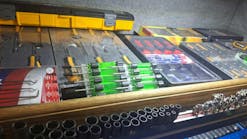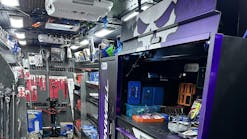Air tools have been a staple in automotive shops for many years. But as technology has improved, cordless power tools have become increasingly more popular with technicians. Distributors that familiarize themselves with the benefits of power tools and share those advantages with customers could see an uptick in sales across the product category.
Whether performing work on wheel lugs, under the hood or to a vehicle’s body, power tools can complete the same tasks as air tools. “Any fastening, cutting, grinding or servicing can be done faster through the use of a power tool,” says Paul Fry, senior VP of product management with Milwaukee Tools. “Virtually every application can be done more easily by using power tools.”
In addition to speed and ease-of-use, a key advantage cordless power tools hold over air tools is the independence of not being tethered to an air compressor. “You’re also not reliant on numerous guys using the same air supply, which can affect the performance of the tool from an output or power standpoint,” says Dave Veprek, director of product development for Stanley Black & Decker – the parent company for DeWalt and Mac Tools power tools.
“Air compressors are an expensive capital expense to shop owners,” Ingersoll Rand global product manager Brian Fetner adds, noting it also can be costly to service compressors.
Along with improved productivity, removing an air hose from the work area may reduce possible hazards and prevents a hose from possibly marring a newly finished surface on the vehicle.
“The freedom that cordless solutions allow translates to greater productivity and safety for the technician,” says Fry. “Operating and maintaining compressors and air lines can be a huge time sink – not to mention, cords can cause various tripping hazards, especially in confined shop spaces.”
The most common power tools employed by techs are cordless impact wrenches, which can remove and install a variety of fasteners. Additionally, cordless impact ratchets are used to install and remove nuts and bolts, and cordless grinders assist in cutting.
Cordless lighting solutions are also a top-selling item among shop owners and techs because they provide illumination away from power outlets.
Trends and technology
The advantages offered by cordless power tools have prompted an increase in technological advancements. Although slightly larger and heavier than some pneumatic options, cordless power tool designs continue to become compact, lightweight and ergonomic, while providing increased power.
“Most technology advancements are in cordless over air,” says Ingersoll Rand’s Fetner. “There is a shift that has begun and will continue. Flexibility is the key in this shift.”
One significant change power tool manufacturers made was utilizing Lithium-ion battery packs instead of NiCad batteries. Li-ion provides greater power for longer periods of time, and the newer batteries do not self-discharge. Depending on usage, some cordless power tools can offer several days of run-time on a battery charge. However, if repetitive maintenance applications are performed, multiple battery packs may be needed to get through a day’s work.
Additionally, many of today’s power tools use brushless motors, allowing a higher power density. “You can get more power out of the same motor, so you can build tools smaller and improve ergonomics,” Stanley Black & Decker’s Veprek says. “They’re more efficient. You don’t have any loss of energy and you’re going to get a longer run-time.”
What’s more, several cordless power tools come with built-in LEDs to illuminate the work area.
Improved electronics and smart communication are becoming factors to consider as well, says Milwaukee’s Fry, referring to his company’s One-Key platform, which allows the tool’s owner to manage inventory, generate tool reports by wirelessly synchronizing with a web-based program and control the tool’s use through an app. “The One-Key app will allow users to use pre-determined set-ups for specific fasteners and materials, or completely customize their own profile with torque and speed settings for the application at hand.”
Important specs
Three key factors techs weigh when choosing a power tool are torque output, size and ergonomics. “Don’t get caught up in price and warranty, alone. Remember tool specifications and application needs should be the primary driver for the purchase,” adds Ingersoll Rand’s Fetner.
Distributors also should draw their customers’ attention to a tool’s durability, power rating and warranty. Also, consider the breadth of the product line. If multiple tools from a company operate on the same battery platform, that could lead to multiple tool sales.
Other features to consider include drive or chuck size, rpm, battery voltage and battery charge time.
Tool distributors should identify the customer’s need and how often a tool is used to be sure the tool in questions is designed to handle the rigors of automotive applications. Find out if the shop’s air supply struggles to handle current demands. Don’t be afraid to lend a tool to a customer so they can see its value, firsthand. Additionally, find out if techs need added mobility.
Jody Baker, product manager at Matco Tools suggests distributors ask: “What jobs are you performing mostly? Have you had any difficulties using your current product?”
“If a tech hasn’t purchased (cordless) tools within the last three years, he should consider upgrading,” Baker advises.
Stanley Black & Decker’s Veprek agrees, adding, “I’ve been in a lot of shops and there’s still guys using pneumatics that haven’t looked at a cordless impact wrench in years.
“The capabilities of cordless tools in the last 10 years have drastically changed, and they’re going to continue to change based on new technologies and batteries and motors,” he continues. “There’s going to be a lot of things they couldn’t have done in the past that they can do with cordless today.”
Urge technicians to re-educate themselves on what cordless power tools can provide because there’s an opportunity for more productivity within each service bay.


